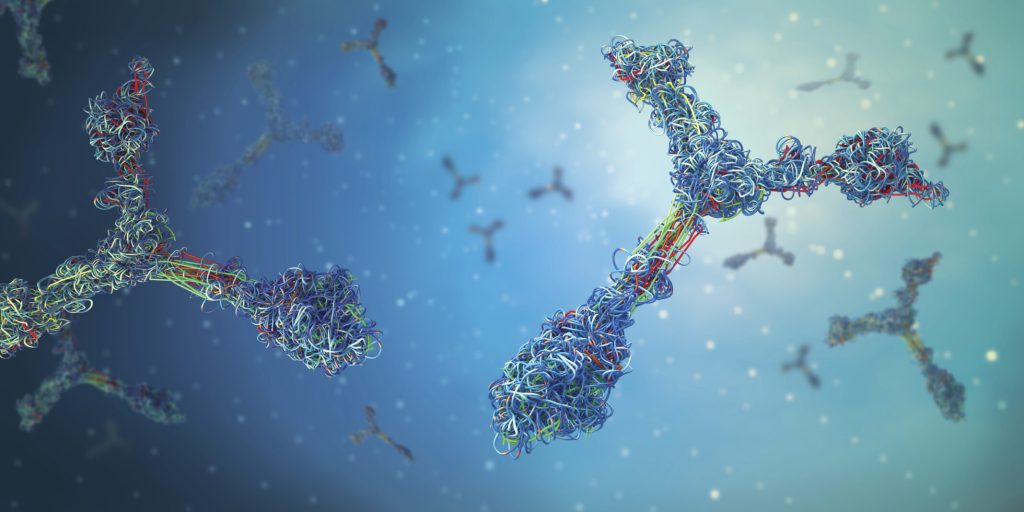A massive crowd of people shouts as one, “WE ARE ALL INDIVIDUALS!” Then, a lone person in the crowd sheepishly mutters, “I’m not.”
The scene above, one of the best from the Monty Python troupe, brings to mind a phenomenon known as the immunodominant public antibody response. It is a widely shared immune response to a pathogen. In different people, the same epitopes on viral proteins end up being targeted by the same antibodies—public antibodies.

The phenomenon, which appears to reflect our immune systems’ tendency to be efficient, can sometimes leave us vulnerable. That is, it may cause us to produce antibodies that repeatedly target the same epitopes, even if the antibodies are not protective. Or, it can give viruses, such as SARS-CoV-2, an easy way to evade the immune response. For example, a virus could mutate just a few target residues and gain the ability to outmaneuver antibodies that are widely shared by many people.
A better understanding of the phenomenon is now possible thanks to a new study led by investigators from Brigham and Women’s Hospital. According to this study, the generation of antibodies is far from random because of germline-encoded amino acid–binding (GRAB) motifs. GRAB motifs represent a germline-encoded component of the architecture of the antibody repertoire that predisposes antibodies to recognize particular structures and thus influences epitope selection and composition.
The study—”Germline-encoded amino acid–binding motifs drive immunodominant public antibody responses”—was published in Science. “Our research may help explain a lot of the patterns we’ve seen during the COVID-19 pandemic, especially in terms of re-infection,” said corresponding author Stephen J. Elledge, PhD, the Gregor Mendel professor of genetics at the Brigham and Harvard Medical School. “Our findings could help inform immune predictions and may change the way people think about immune strategies.”
Before the study, there were hints, but no clear evidence, that people’s immune systems didn’t target sites on a viral protein at random. In isolated examples, investigators had seen recurrent antibody responses across individuals—people recreating antibodies to home in on the same viral protein location (known as an epitope). But the study by Elledge and colleagues helps explain the extent and underlying mechanisms of this phenomenon.
The team used a tool the Elledge lab developed in 2015 called VirScan, which can detect thousands of viral epitopes—sites on viruses that antibodies recognize and bind to—and give a snapshot of a person’s immunological history from a single drop of blood. For the new study, the researchers used VirScan to analyze 569 blood samples from participants in the United States, Peru, and France. They found that recognition of public epitopes—viral regions recurrently targeted by antibodies—was a general feature of the human antibody response.
“By mapping 376 immunodominant ‘public epitopes’ at high resolution and characterizing several of their cognate antibodies, we concluded that germline-encoded sequences in antibodies drive recurrent recognition,” the article’s authors wrote. “Systematic analysis of antibody-antigen structures uncovered 18 human and 21 partially overlapping mouse GRAB motifs within heavy and light V gene segments that in case studies proved critical for public epitope recognition.”
GRAB motifs correspond to antibody regions that are particularly good at picking out one specific amino acid. They help explain why human antibodies tend to focus on regions where these amino acids are available for binding, and thus repeatedly bind the same spots. A small number of mutations can help a virus avoid detection by these shared antibodies, allowing the virus to reinfect populations that were previously immune.
“We find an underlying architecture in the immune system that causes people, no matter where in the world they live, to make essentially the same antibodies that give the virus a very small number of targets to evade in order to reinfect people and continue to expand and further evolve,” said lead author Ellen L. Shrock, PhD, of the Elledge lab.
Interestingly, the team noted that nonhuman species produce antibodies that recognize different public epitopes from those that humans recognize. And, while it is more likely for a person to produce antibodies against a public epitope, some people do produce rarer antibodies, which may more effectively protect them from reinfection. These insights could have important implications for treatments developed against COVID-19, such as monoclonal antibodies, as well as for vaccine design.
“The more unique antibodies may be a lot harder to evade,” Elledge said. “[This] is important to consider as we think about the design of better therapies and vaccines.”